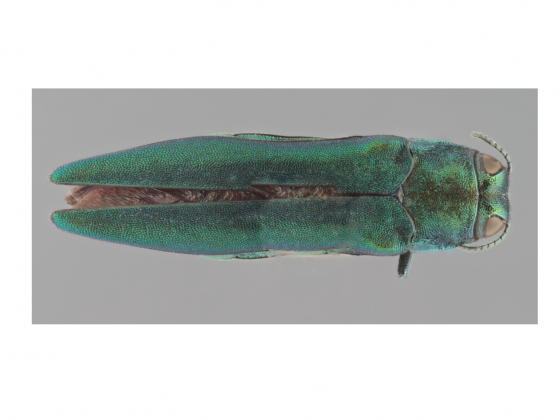The emerald ash borer is a destructive wood-boring beetle that has killed millions of ash trees in North America, said Laurie Kerzicnik, MSU associate Extension specialist in the College of Agriculture’s Department of Plant Sciences and Plant Pathology. The beetle was first discovered in Detroit, Michigan, in 2002, likely coming from wood packaging material imported from Asia. Since its arrival in the U.S., the emerald ash borer has become widely established in 35 states and five Canadian provinces.
“The emerald ash borer has not been detected in Montana yet,” said Kerzicnik. “But because it can be transported on firewood and pallets, the risk of it being introduced in the state is high.”

Kerzicnik collaborated with several agencies statewide to create a new fact sheet about emerald ash borer biology and the symptoms of beetle damage. The fact sheet also includes suggestions for how landowners and recreationists can decrease beetle spread, management recommendations if the beetles are found in Montana, and information about other pests that affect ash trees. It can be accessed at https://ipm.montana.edu/documents/ent-fact-sheets-2020/eab_fact_sheet.pdf or https://ipm.montana.edu/entomology/.
The Department of Natural Resources and Conservation, city foresters across Montana, the U.S. Forest Service, the USDA Animal and Plant Health Inspection Service, The Nature Conservancy, the Montana Department of Agriculture, the Montana Urban and Community Forestry Association and the Montana Invasive Species Council collaborated with Extension to put on educational presentations and workshops and place billboards around the state. The Nature Conservancy’s Don’t Move Firewood campaign encouraged people who buy firewood to “buy it where you burn it,” to avoid transporting insects that may be on purchased wood.
Statewide monitoring for the emerald ash borer has been conducted in Montana since 2008, said Kerzicnik. That includes setting traps to monitor the prevalence of certain types of pests, branch sampling and field visits to respond to potential beetle-infested trees. City foresters have also engaged in tree inventories to document the percentage of ash trees in major Montana cities and the impact the beetles could have on urban communities.
Several prevention and mitigation efforts by city foresters are underway and will continue, said Kerzicnik, including reducing the abundance of ash trees in communities, removal of hazardous ash trees and increasing the species diversity of trees in the state’s urban areas.
“The overarching goal of these collective efforts is to reduce financial and aesthetic impacts of the pest if it arrives in Montana,” Kerzicnik said. “We value these collaborations and the shared ambition of maintaining healthy and diverse urban forests throughout Montana.”

